National Symbols of the Ukrainian People’s Republic With the Trident on the Seal and in the Heart
8/17/2021
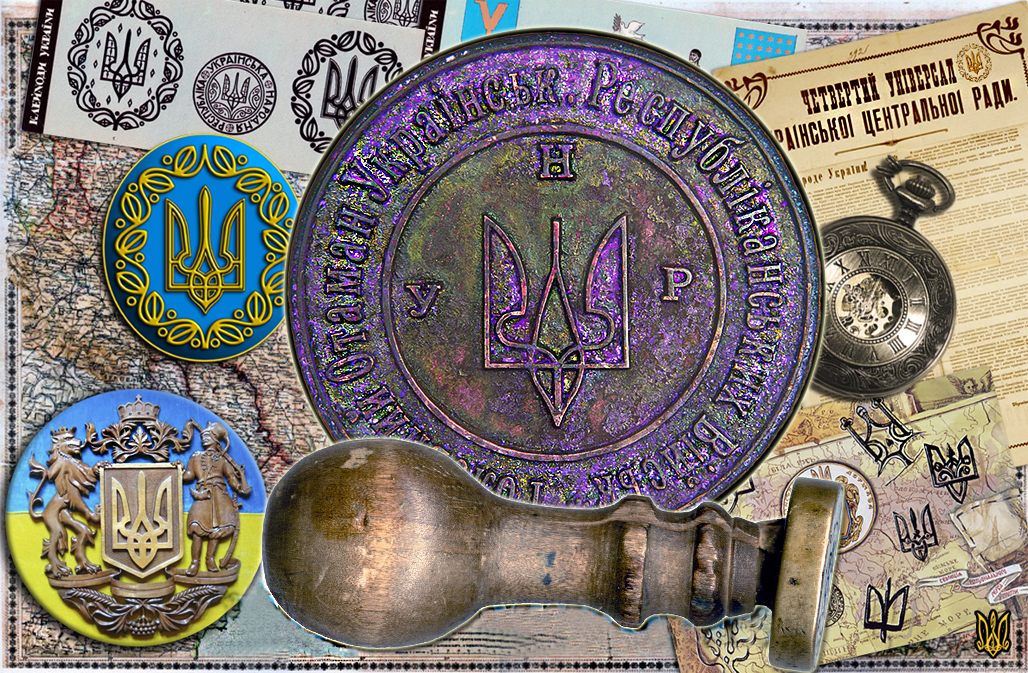
During the existence of the UPR government and other Ukrainian organizations in exile, national symbols continued to be actively used on items of clothing, flags, awards, decorations and, most of all, in document circulation. This is evidenced by materials from the archival funds of the interwar period. Seals, stamps, forms of documents usually contained the coat of arms-trident. Different in form and layout, they now serve as a kind of reflection of the bygone era and an important source for research by scholars and historians.
Ukrainian national-state symbols were finally formed in 1917–1920 as identification attributes of the national liberation movement. When creating both the flag and the national emblem, they relied on historical traditions of ancient forms of Ukrainian statehood. However, at that time there were some differences in the images. This is explained by the fact that during the times of the Ukrainian Central Rada and the Ukrainian State of Hetman Skoropadsky, the heraldic system underwent certain changes.
That is why some features of the heraldic elements of both the supporters of the State Center of the Ukrainian People's Republic in exile and the supporters of the Hetmanate - representatives of the “Union of Hetman-Statesmen” - remained in exile. The Branch State Archives of the Foreign Intelligence Service of Ukraine contain a number of documents from 1919–1920, when the government and the army of the Ukrainian People's Republic were still operating on their own territory. They are on pre-printed forms, which were hurriedly approved and produced in stationary or field printing houses in conditions of constant hostilities.
These forms have the following inscriptions: “Office of the Otaman-in-Chief of the Troops of the Ukrainian People's Republic. Headquarters” (July 1920), “U.P.R. Adjutant of the Otaman-in-Chief of the Troops of the Ukrainian People’s Republic. Headquarters” (March 1920), “U.P.R. Headquarters of the Iv. Mazepa Insurgent Detachment” (191_), “U.P.R. Commander of the 5th Kyiv Cavalry Regiment. D. Army” (October 1920), “Director of the State Bank of Ukraine” (March 1919), “U.P.R. Ukrainian Diplomatic Mission in the Rzeczpospolita Polska. Military officer. Warsaw”(March 1920) and others.
A number of documents date back to 1921–1922, when the Ukrainian government and army were forced to leave Ukraine under pressure from Bolshevik troops. They are made on forms with the following pre-printed wording: “Head of the Directory. Otaman-in Chief of the Troops of the Ukrainian People's Republic” (July 1921), “U.P.R. Ministry of Public Education. Department of General Affairs” (August 1922) and others.
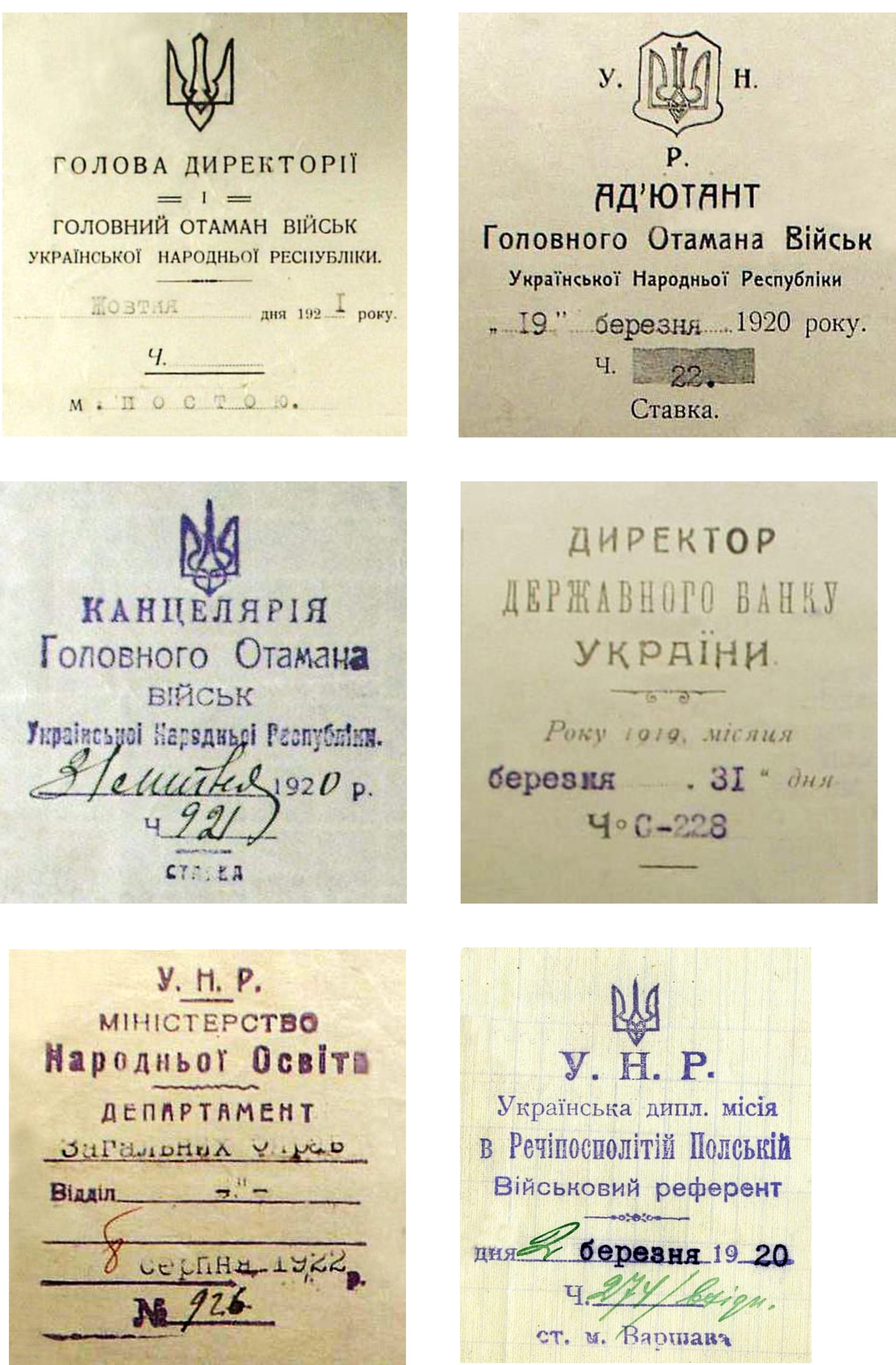
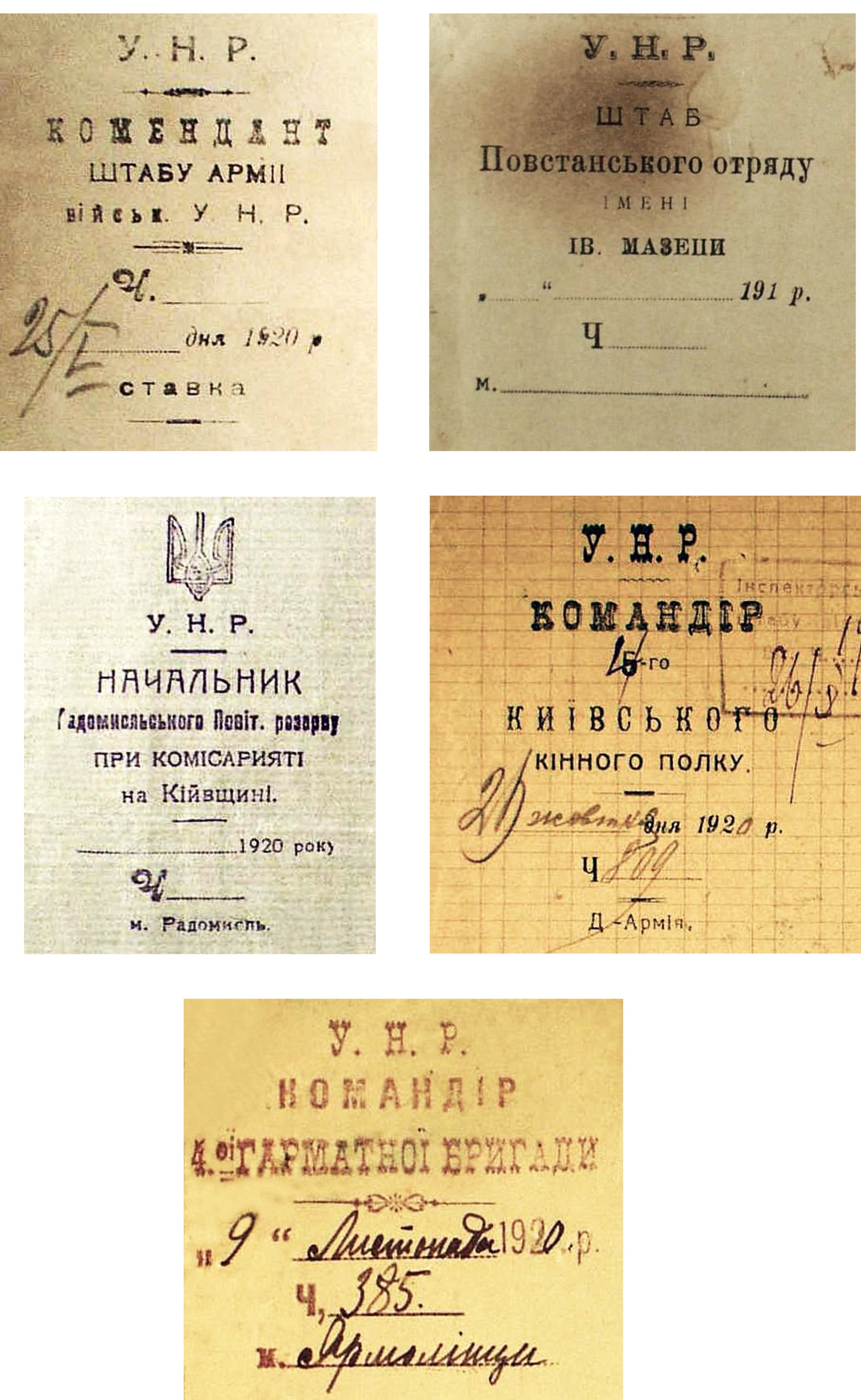 Almost all of these forms have a trident. This heraldic element is invariably present on the seals. The wordings on them are various and, obviously, made without observance of any clearly established requirements. Obviously, such norms, especially in exile, did not exist. Therefore, the texts on the seal impressions are as follows: “Secretary of State”, “Ministry of Foreign Affairs”, “Ukrainian Diplomatic Mission in the Rzeczpospolita Polska”, “Extraordinary Diplomatic Mission of the U.P.R. in Romania”, “Consulate of the Ukrainian People's Republic in Latvia”, “U.P.R. Central Administration of the All-Ukrainian Union of Disabled Soldiers”, Society of Former Soldiers of the U.P.R. Army”, etc.
Almost all of these forms have a trident. This heraldic element is invariably present on the seals. The wordings on them are various and, obviously, made without observance of any clearly established requirements. Obviously, such norms, especially in exile, did not exist. Therefore, the texts on the seal impressions are as follows: “Secretary of State”, “Ministry of Foreign Affairs”, “Ukrainian Diplomatic Mission in the Rzeczpospolita Polska”, “Extraordinary Diplomatic Mission of the U.P.R. in Romania”, “Consulate of the Ukrainian People's Republic in Latvia”, “U.P.R. Central Administration of the All-Ukrainian Union of Disabled Soldiers”, Society of Former Soldiers of the U.P.R. Army”, etc.
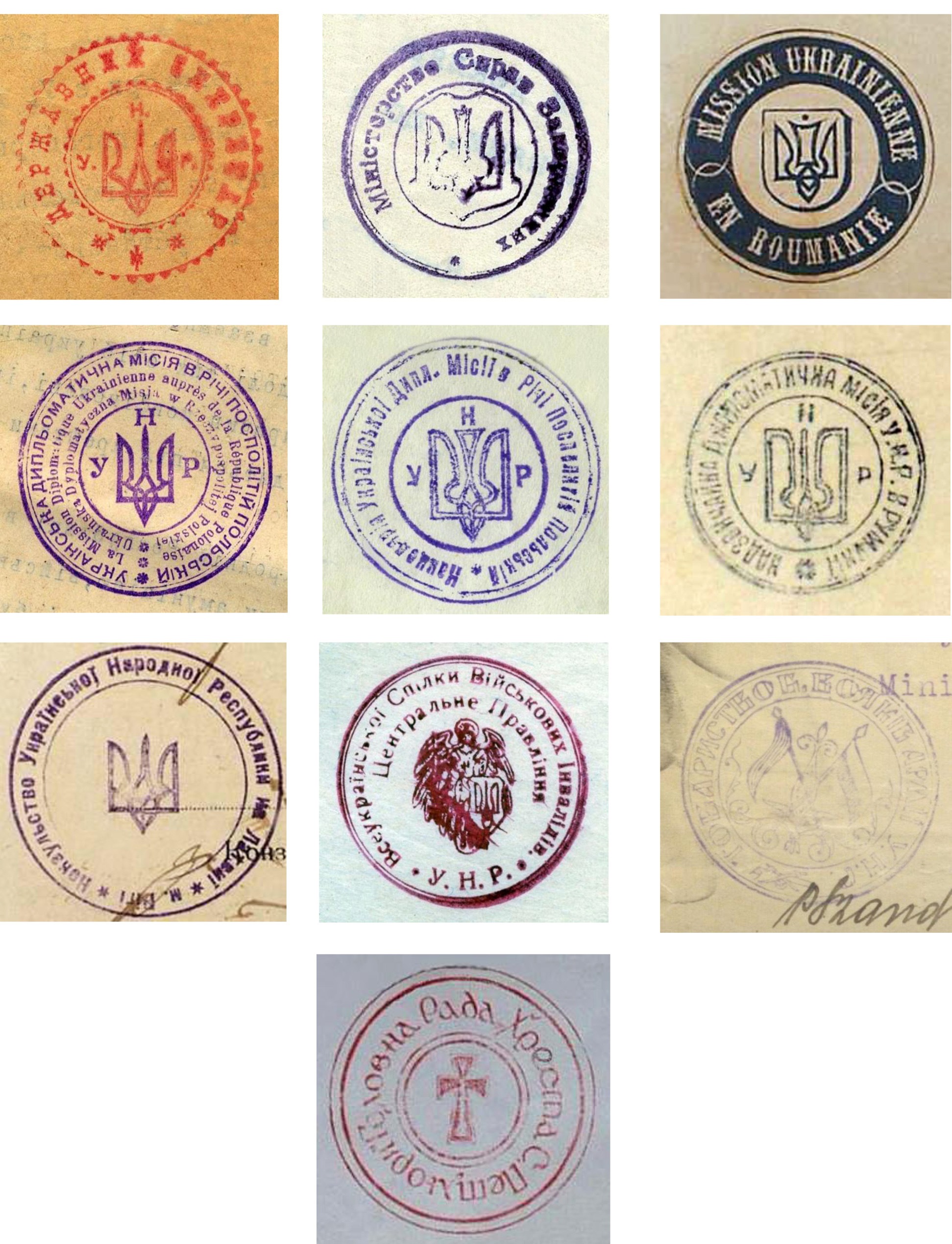 Among the seal imprints there is the following inscription: “Main Council of the Cross of S. Petliura”, which in the central part depicts not a trident, but the Cross of Symon Petliura. It was an award, approved in 1932 which was given to participants in the liberation movement. The award was designed by the well-known Ukrainian heraldist Mykola Bytynskyi.
Among the seal imprints there is the following inscription: “Main Council of the Cross of S. Petliura”, which in the central part depicts not a trident, but the Cross of Symon Petliura. It was an award, approved in 1932 which was given to participants in the liberation movement. The award was designed by the well-known Ukrainian heraldist Mykola Bytynskyi.
Among the archival documents there is the original of the Diploma dated May 22, 1932, on awarding Lieutenant Andriy Dubynovskyi the “Cross of Simon Petliura” “for participation in the armed struggle for the Statehood of Ukraine under the leadership of Otaman –in –Chief Symon Petliura”. It is sealed with a special seal.
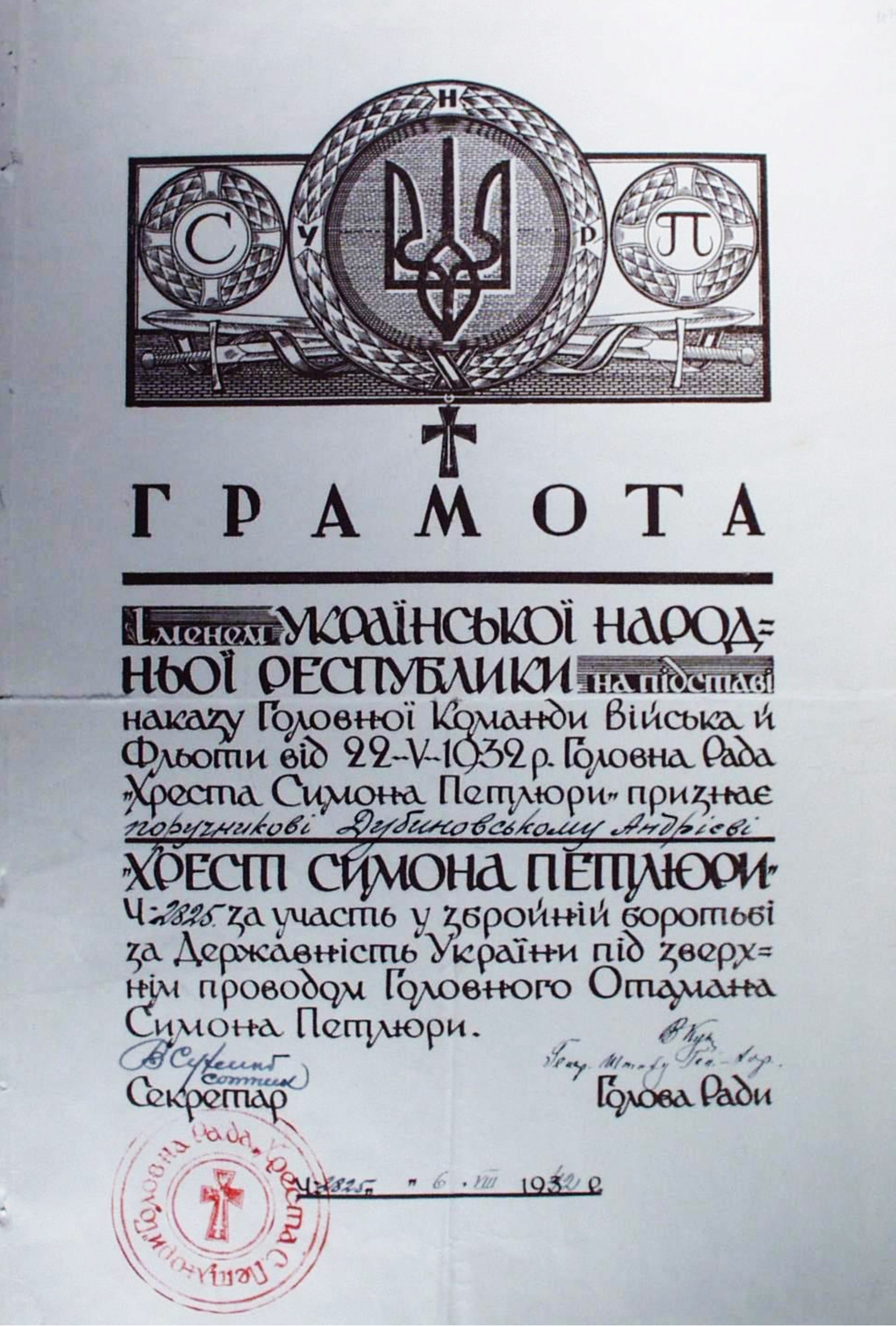 Among the information about the heraldic elements of the Hetmanites, of special interest is the letter of Serhiy Shemet, the personal secretary of Hetman Skoropadskyi, to the Commanding Otaman of the “Union of Hetman-Statesmen” in America dated December 28, 1934. It contains a request to send a sketch or a copy of the Emblem that the Hetman's Administration intended to order for its members. At this, S. Shemet points out that the Hetman's Administration is developing the form of such an emblem, which “should be combined with the national emblem of Ukraine (trident with a cross on the central axis) and some emblems from the family coat of arms of the Skoropadskyi family”. Besides, the author of the letter draws attention to the fact that “the Hetmanate in 1918 adopted as a state emblem a trident with a cross and that all Hetman organizations now in memory of the Hetman statehood tradition should use the state emblem, which was adopted during the Hetmanate in 1918”(BSA of the SZR of Ukraine. - F. 1. – Case 7242.– V. 12. - P. 185).
Among the information about the heraldic elements of the Hetmanites, of special interest is the letter of Serhiy Shemet, the personal secretary of Hetman Skoropadskyi, to the Commanding Otaman of the “Union of Hetman-Statesmen” in America dated December 28, 1934. It contains a request to send a sketch or a copy of the Emblem that the Hetman's Administration intended to order for its members. At this, S. Shemet points out that the Hetman's Administration is developing the form of such an emblem, which “should be combined with the national emblem of Ukraine (trident with a cross on the central axis) and some emblems from the family coat of arms of the Skoropadskyi family”. Besides, the author of the letter draws attention to the fact that “the Hetmanate in 1918 adopted as a state emblem a trident with a cross and that all Hetman organizations now in memory of the Hetman statehood tradition should use the state emblem, which was adopted during the Hetmanate in 1918”(BSA of the SZR of Ukraine. - F. 1. – Case 7242.– V. 12. - P. 185).
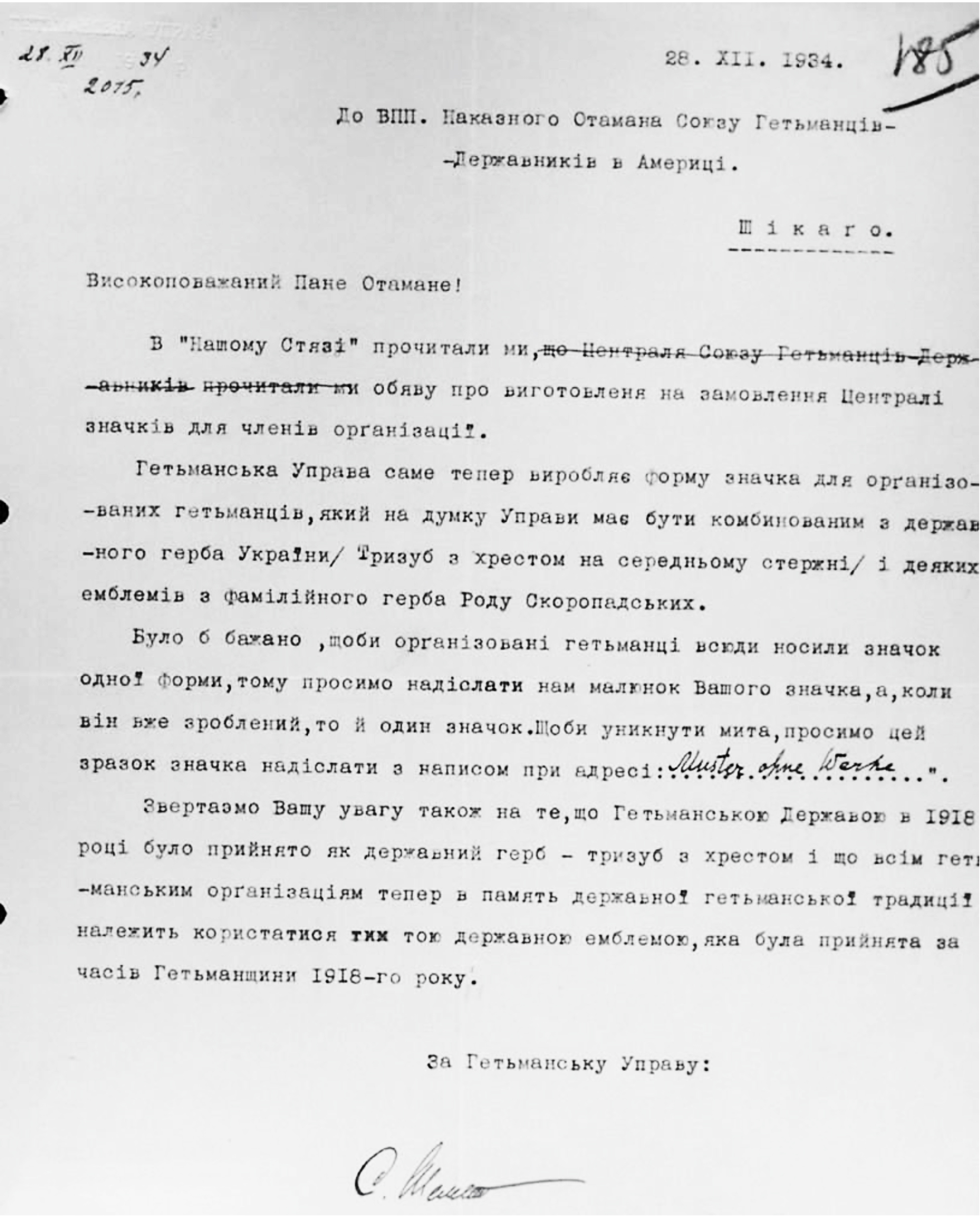 The recommendations were soon taken into consideration during the creation of the Emblem of the Union of Hetman-Statesmen – an award given to members of the emigration association of supporters of the Hetmanate. In the centre of the award there is a trident with a cross. The centre of the sign is on the “Serdyuks’ star”, i.e. the cockade, which was created in the summer of 1918 for a separate Serdyuks’ division - the guard of Pavlo Skoropadskyi. The motto “For a Free State of Ukraine” shows the belonging to the organization of the Union of Hetman-Statesmen.
The recommendations were soon taken into consideration during the creation of the Emblem of the Union of Hetman-Statesmen – an award given to members of the emigration association of supporters of the Hetmanate. In the centre of the award there is a trident with a cross. The centre of the sign is on the “Serdyuks’ star”, i.e. the cockade, which was created in the summer of 1918 for a separate Serdyuks’ division - the guard of Pavlo Skoropadskyi. The motto “For a Free State of Ukraine” shows the belonging to the organization of the Union of Hetman-Statesmen.
Among the archival documents there is a black and white image of the flag of the Hetmanites of that period. The inscription on the photo indicates that it is “The flag of the 6th Kish of the I District of the Union of Hetman Statesmen, Sudbury, Ontario, Canada. Blest on November 17, 1935 in the Ukrainian Catholic Church” (BSA of the SZR of Ukraine. - F. 1. - Case 7242.– Vol. 16. - P. 380). All the participants in the ceremony are in uniform and the atmosphere is solemn.
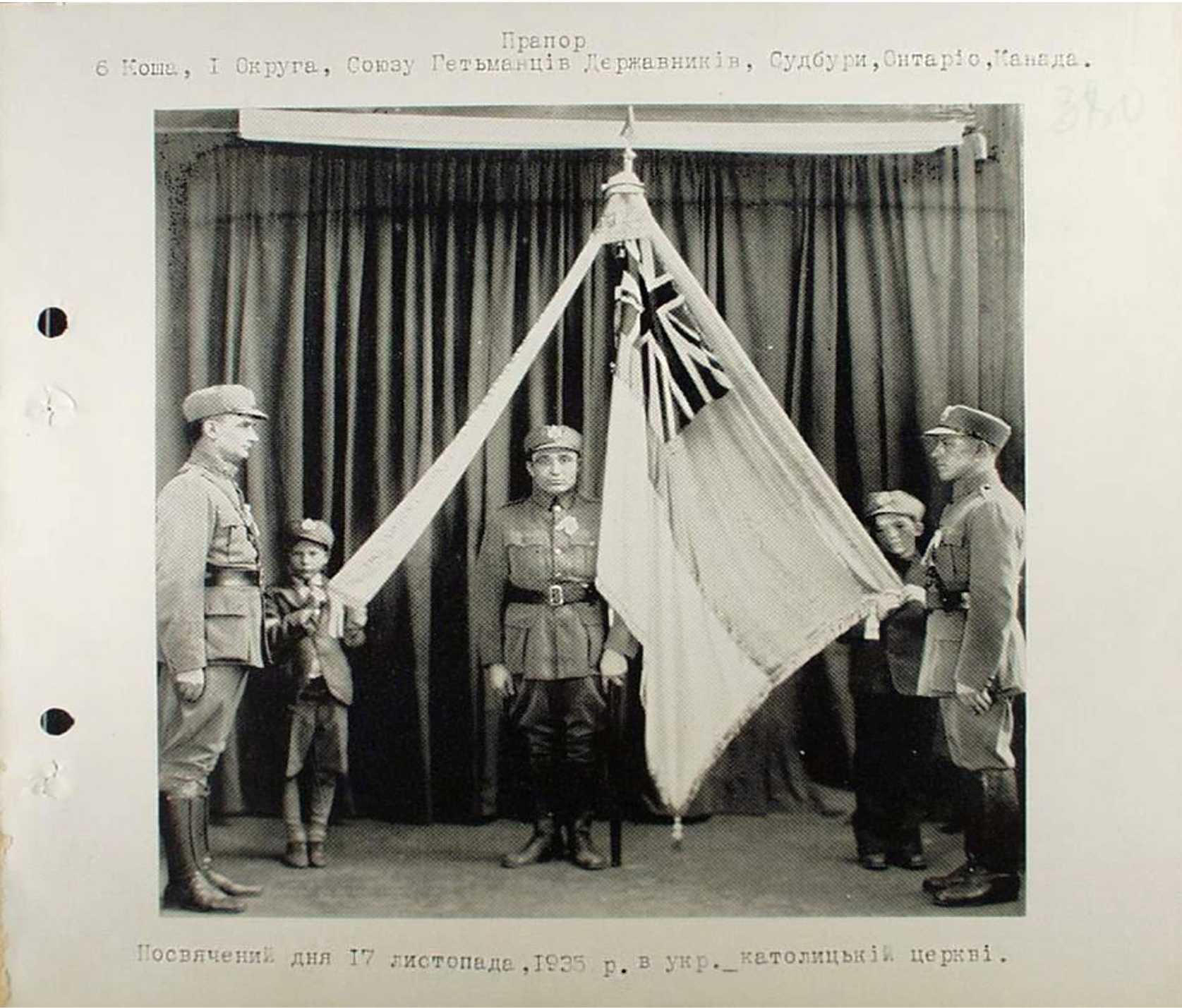 The documents of the leading figures of the Hetman-statesmen of that period bear the signatures of Oleksandr Shapoval, Mykhailo Soltys, Mykola Hul, Hryhoriy Matviyiv, and others, and are mostly sealed with the seals of the Union of Hetman's Organizations of America and Canada.
The documents of the leading figures of the Hetman-statesmen of that period bear the signatures of Oleksandr Shapoval, Mykhailo Soltys, Mykola Hul, Hryhoriy Matviyiv, and others, and are mostly sealed with the seals of the Union of Hetman's Organizations of America and Canada.
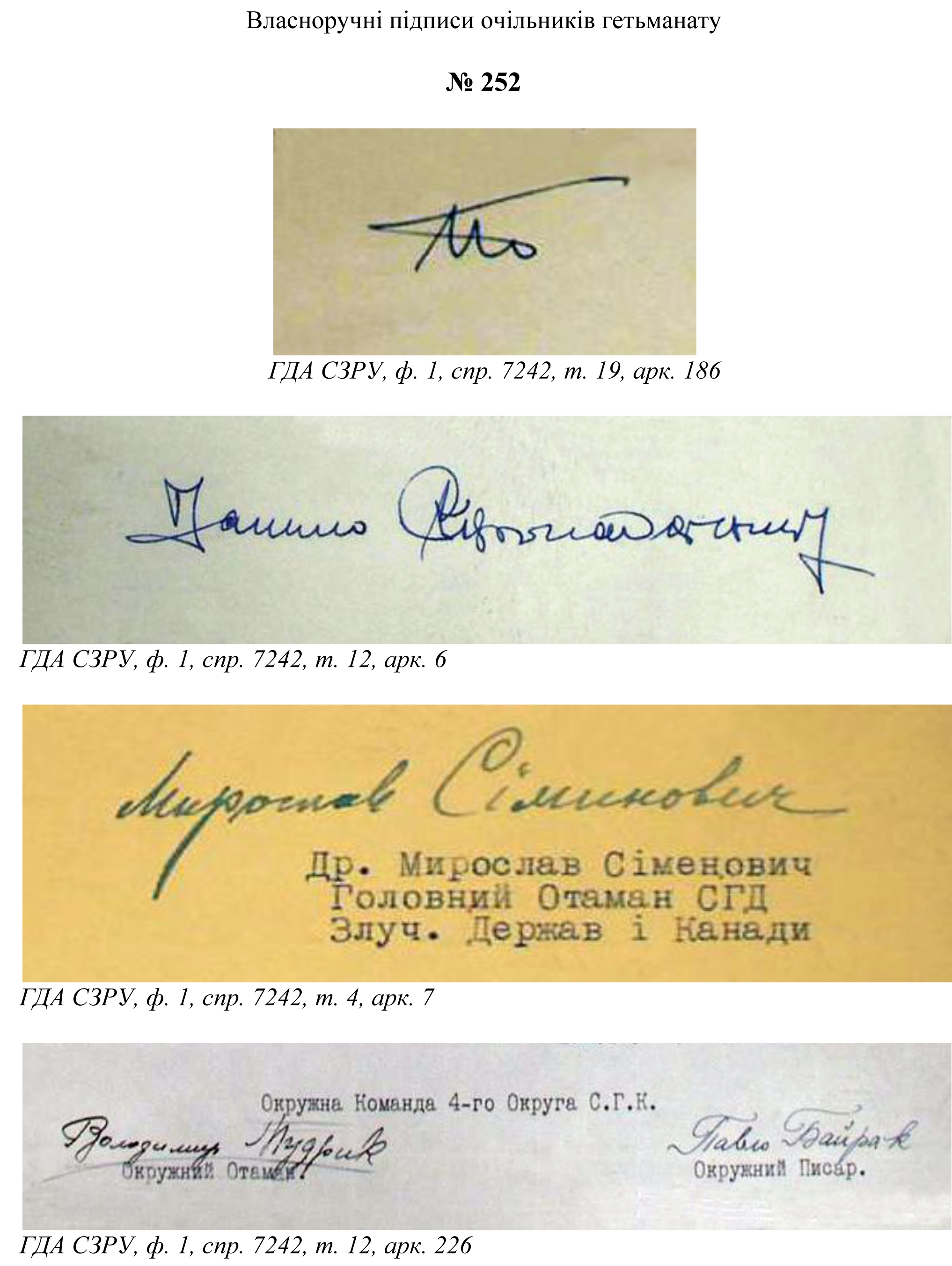
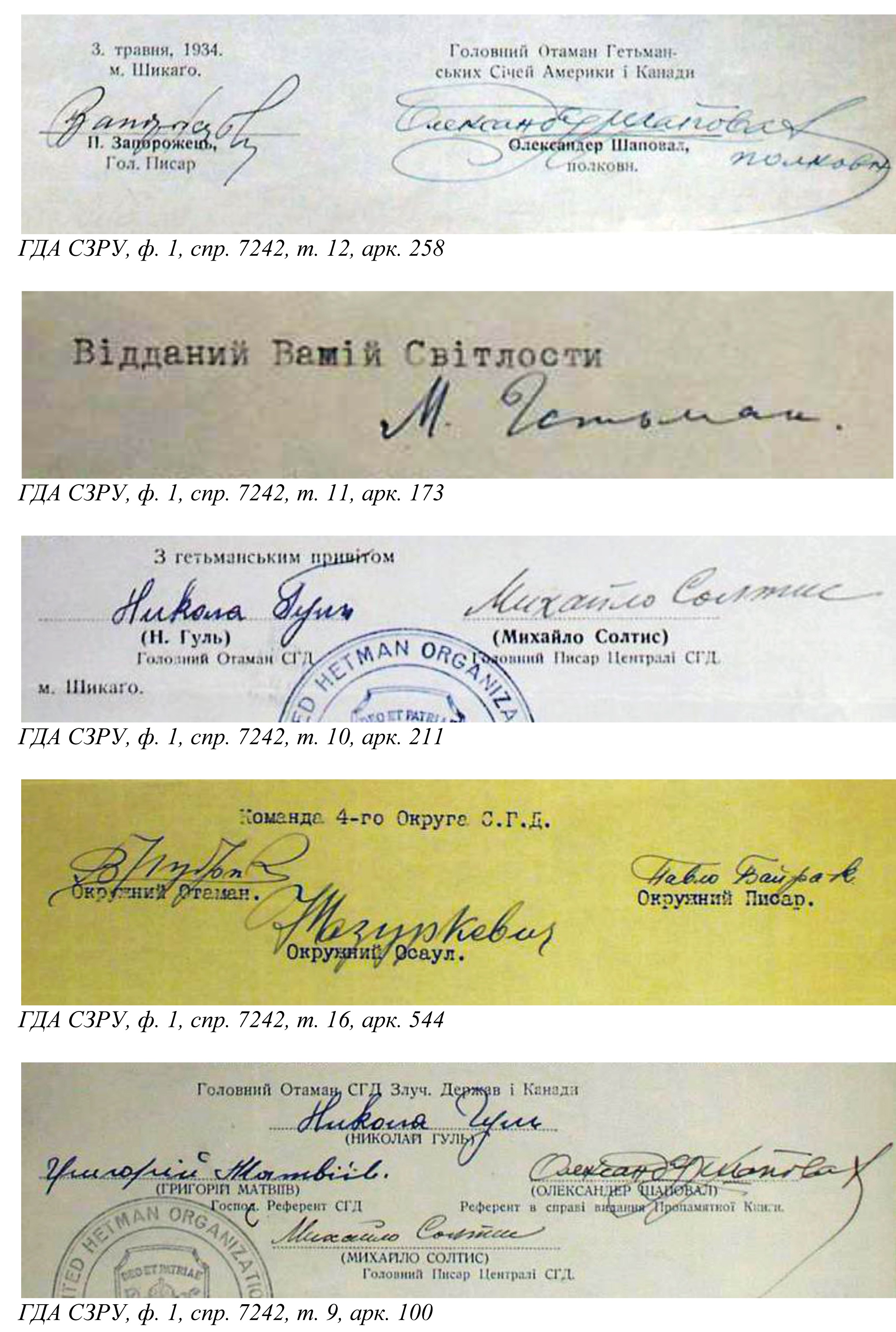
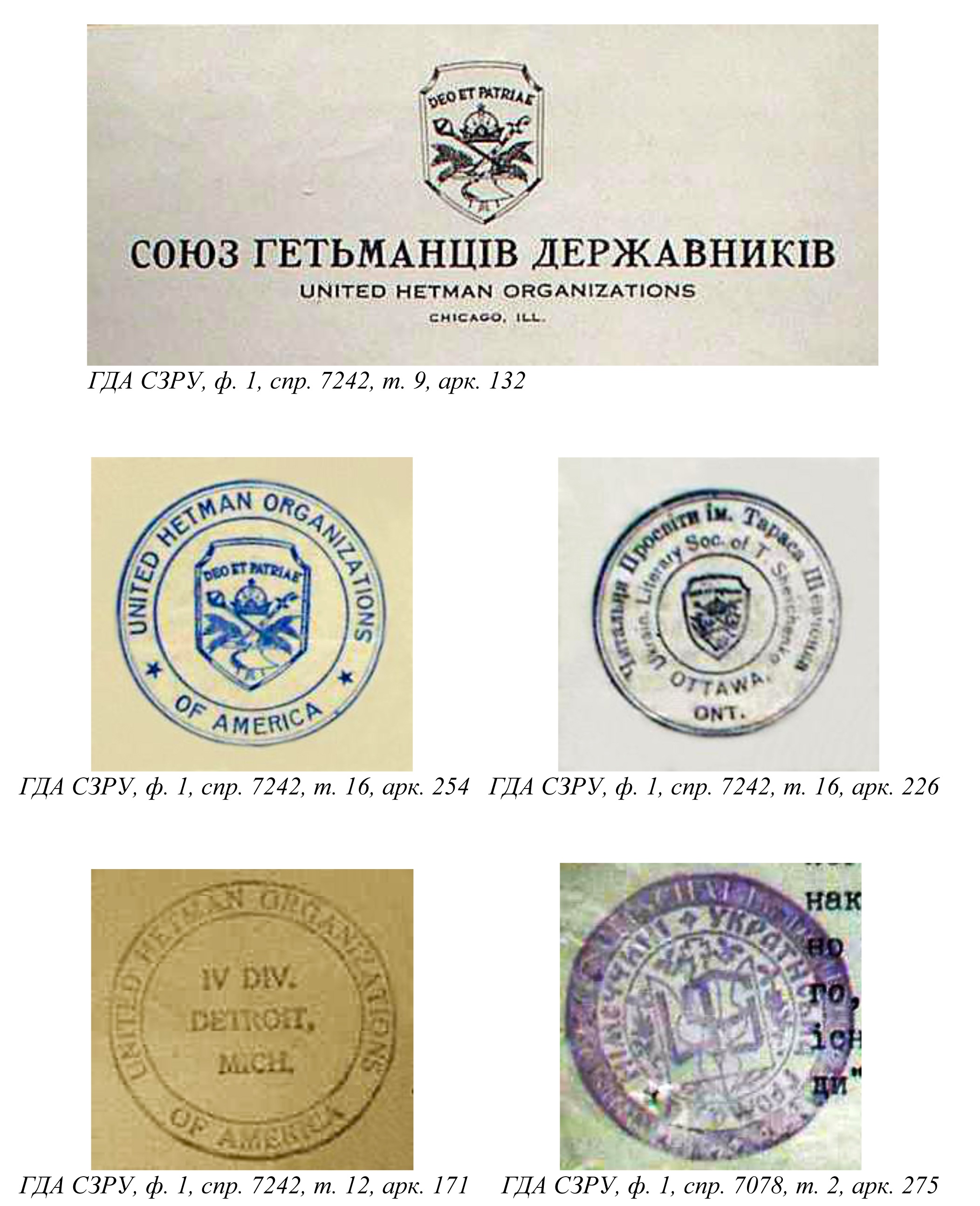 Preservation of national state traditions and symbols of Ukraine was an important part of the life of Ukrainians in exile. It united them in difficult living conditions abroad, testified to national identity, respect for national shrines, gave moral support and encouraged not to abandon the struggle for the restoration of independence of the Ukrainian state.
Preservation of national state traditions and symbols of Ukraine was an important part of the life of Ukrainians in exile. It united them in difficult living conditions abroad, testified to national identity, respect for national shrines, gave moral support and encouraged not to abandon the struggle for the restoration of independence of the Ukrainian state.
